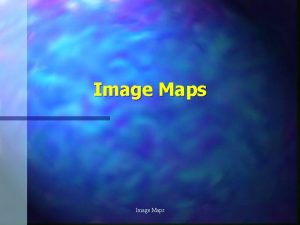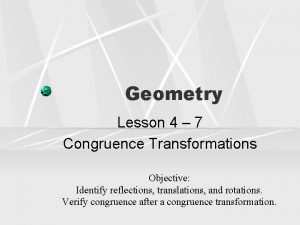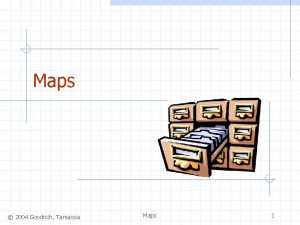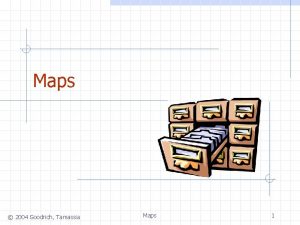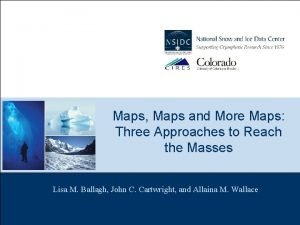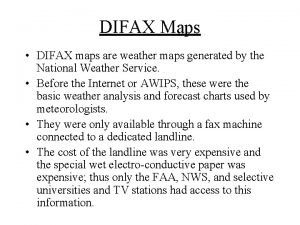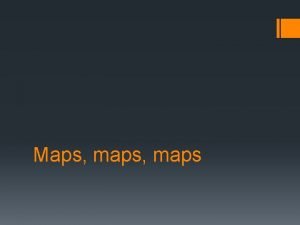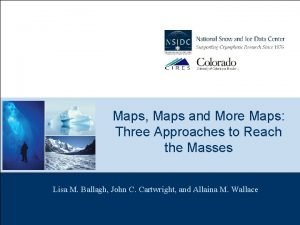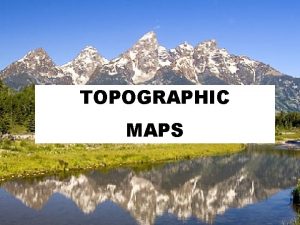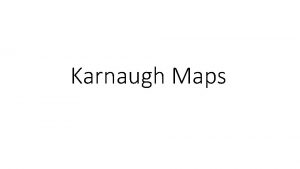Image Maps Lecture 14 Image Maps An image











- Slides: 11

Image Maps Lecture 14

Image Maps § An image map is a single image that can be used to link to several different Hot Spots URLS

Image Maps § § § Server-Side Image Maps Client-Side Image Maps Summary: Image Maps

Server-Side Image Maps § Image used as image map § Map file defines areas of image and corresponding URLs § Image map program runs on server as part of its server software § Map file and image map program reside on server § Web server performs calculations

Client-Side Image Maps § HTML document contains map information § Browser performs calculations § Better performance that server-side image maps § Can test and implement locally § URL of hyperlink will display in browser status bar when mouse hovers over

Four Steps to Create a Client-Side Image Map 1. Select image to use 2. Define areas of image map § Three shapes: circle, rectangle, polygon § X and Y coordinates in pixels § Get coordinates from a graphics program such as Paint Shop Pro or Photoshop

Four Steps to Create a Client-Side Image Map 3. Include map information in HTML document: § <MAP></MAP> - NAME attribute names the map § <AREA> tags identify shapes in map – SHAPE attribute – circle, rect, poly – HREF attribute – URL to load – COORDS – x and y coordinates of shape 4. Connect image with map information § USEMAP attribute in <IMG> tag § USEMAP value is map name with a # symbol before it

Finding Coordinates § Open image in Irfanview or some other graphics program § Point to the locations of interest and click to see the X, Y coordinates in the title bar

Circle <AREA SHAPE=“circle” COORDS=“x, y, r” HREF=“url”> § Replace x, y, r with three numbers: horizontal and vertical position of the circle’s center, and the radius of the circle in pixels § Replace url with the Web address of the link target x, y x+r, y

Rectangle <AREA SHAPE=“rect” COORDS=“x 1, y 1, x 2, y 2” HREF=“url”> § Replace x 1, y 1 with two numbers: horizontal and vertical position of one corner of the rectangle § Replace x 2, y 2 with the horizontal and vertical position of the opposite corner of the rectangle § Replace url with the Web address of the link target x 1, y 1 x 2, y 2

Polygon x 1, y 1 <AREA SHAPE=“poly” COORDS=“x 1, y 1, x 2, y 2, x 3, y 3, x 4, y 4, …” HREF=“url”> x 6, y 6 § Replace x 1, y 1 with two numbers: horizontal and vertical position of a point on the edge of x 5, y 5 the polygon § Add more x, y pairs until you have traced around the desired shape x 2, y 2 x 3, y 3 x 4, y 4
 01:640:244 lecture notes - lecture 15: plat, idah, farad
01:640:244 lecture notes - lecture 15: plat, idah, farad Google map reittihaku
Google map reittihaku Image processing lecture notes
Image processing lecture notes Euclidean transformation in digital image processing
Euclidean transformation in digital image processing Sciencelearn.org.nz carbon cycle
Sciencelearn.org.nz carbon cycle Client side image processing
Client side image processing Identify the type of congruence transformation?
Identify the type of congruence transformation? Project procurement management lecture notes
Project procurement management lecture notes Lecture about sport
Lecture about sport Healthy lifestyle wrap up lecture
Healthy lifestyle wrap up lecture Meaning of this
Meaning of this Meaning of this
Meaning of this





